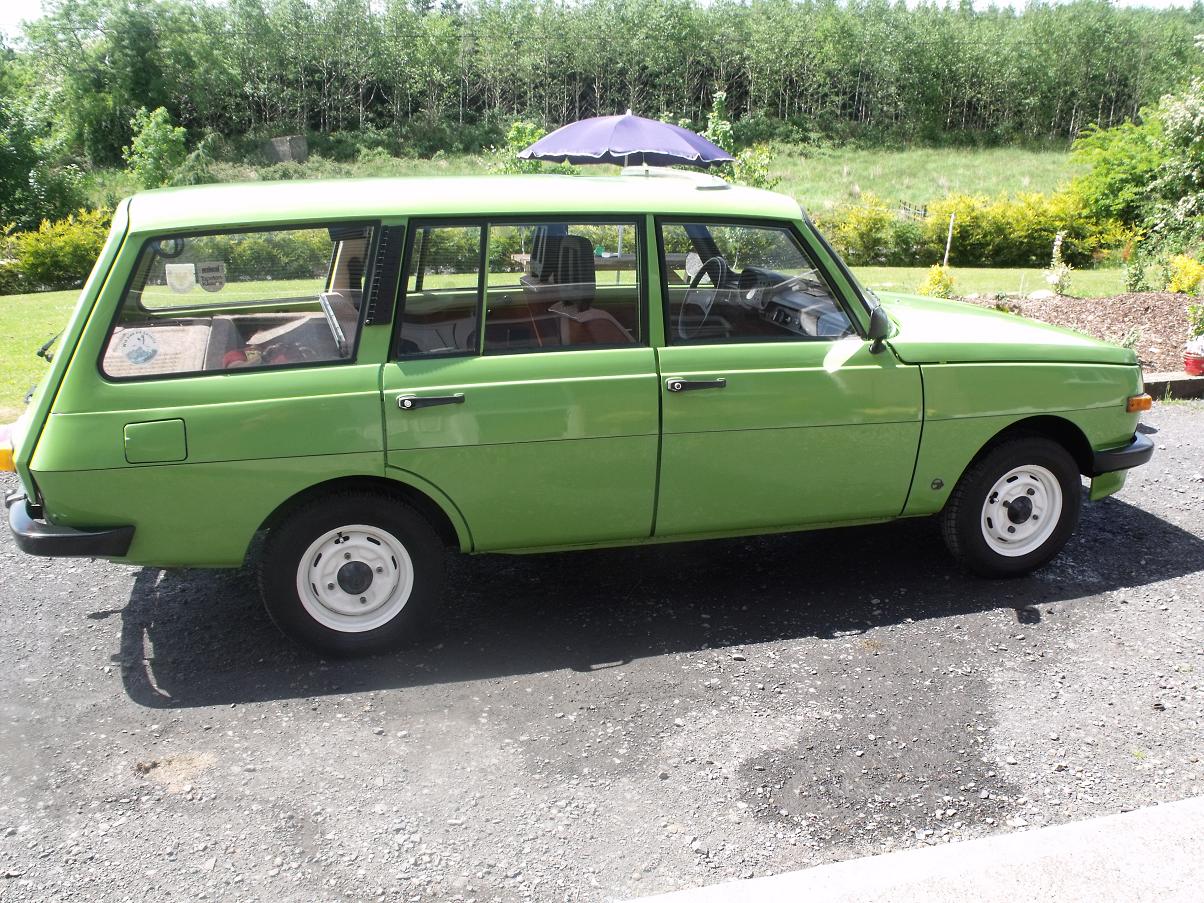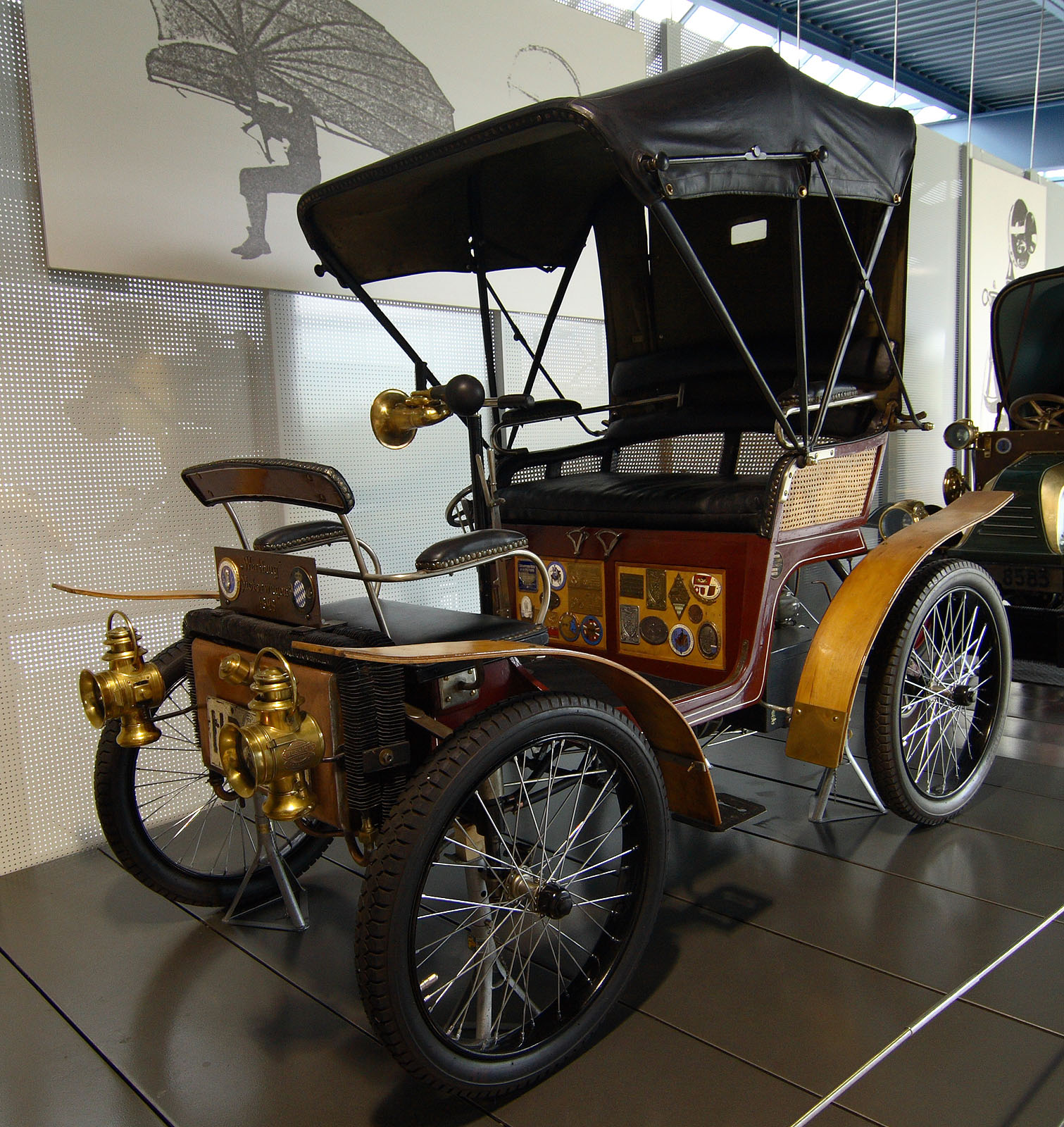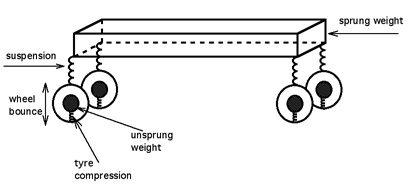|
Wartburg 353
The Wartburg 353, known in some export markets as the Wartburg Knight, is a medium-sized family car, produced by the East German car manufacturer AWE for their Wartburg brand. It was the successor of the Wartburg 311, and was itself succeeded by the Wartburg 1.3. The Wartburg 353 was produced from 1966 to 1988, becoming the Wartburg with the longest production run. During its lifetime it saw several changes and improvements, the most recognizable of these coming in 1985 with a front facelift (as pictured here), slightly different layout around the engine block and a new carburettor. Design First introduced in June 1966, the Wartburg 353 was the creation of the former German BMW production facilities (called EMW under Soviet occupation). Its origins were ultimately derived from a 1938 DKW design, and powered by a two-stroke engine with only seven major moving parts: three pistons, three connecting rods and a crankshaft. This led to a common aphorism among Wartburg owners that "o ... [...More Info...] [...Related Items...] OR: [Wikipedia] [Google] [Baidu] |
Automobilwerk Eisenach
The Automobilwerk Eisenach (AWE) was an automobile manufacturer in Eisenach, Germany. History Fahrzeugfabrik Eisenach Heinrich Ehrhardt founded the Fahrzeugfabrik Eisenach (FFE) in Eisenach on 3 December 1896 as a stock company. Initially, he produced bicycles and guns. After two years, he started to produce a motor car which he called the Wartburg, a licensed model of the French Decauville. The company was the third to manufacture cars in Germany, the first being '' Benz & Cie'' and the second being ''Daimler Motoren Gesellschaft''. His son Gustav subsequently took over the factory, which at the end of the 19th century employed 1,300 workers and was one of the largest in Thuringia. Reorganized as Dixi In 1903, the Ehrhardt family withdrew from management due to financial losses and also because the license to build Decauvilles was revoked. The factory began building under the new name, Dixi, in 1904 with Willi Seck as chief engineer. The top model, the type U35 ... [...More Info...] [...Related Items...] OR: [Wikipedia] [Google] [Baidu] |
Two-stroke Engine
A two-stroke (or two-stroke cycle) engine is a type of internal combustion engine that completes a power cycle with two strokes (up and down movements) of the piston during one power cycle, this power cycle being completed in one revolution of the crankshaft. A four-stroke engine requires four strokes of the piston to complete a power cycle during two crankshaft revolutions. In a two-stroke engine, the end of the combustion stroke and the beginning of the compression stroke happen simultaneously, with the intake and exhaust (or scavenging) functions occurring at the same time. Two-stroke engines often have a high power-to-weight ratio, power being available in a narrow range of rotational speeds called the power band. Two-stroke engines have fewer moving parts than four-stroke engines. History The first commercial two-stroke engine involving cylinder compression is attributed to Scottish engineer Dugald Clerk, who patented his design in 1881. However, unlike most later two-s ... [...More Info...] [...Related Items...] OR: [Wikipedia] [Google] [Baidu] |
Freewheel
Freewheel mechanism In mechanical or automotive engineering, a freewheel or overrunning clutch is a device in a transmission that disengages the driveshaft from the driven shaft when the driven shaft rotates faster than the driveshaft. An overdrive is sometimes mistakenly called a freewheel, but is otherwise unrelated. The condition of a driven shaft spinning faster than its driveshaft exists in most bicycles when the rider stops pedaling. In a fixed-gear bicycle, without a freewheel, the rear wheel drives the pedals around. An analogous condition exists in an automobile with a manual transmission going downhill, or any situation where the driver takes their foot off the gas pedal, closing the throttle: the wheels drive the engine, possibly at a higher RPM. In a two-stroke engine, this can be catastrophic—as many two stroke engines depend on a fuel/oil mixture for lubrication, a shortage of fuel to the engine starves oil from the cylinders, and the pistons can soon seize, ... [...More Info...] [...Related Items...] OR: [Wikipedia] [Google] [Baidu] |
Green Car In Ireland
Green is the color between cyan and yellow on the visible spectrum. It is evoked by light which has a dominant wavelength of roughly 495570 nm. In subtractive color systems, used in painting and color printing, it is created by a combination of yellow and cyan; in the RGB color model, used on television and computer screens, it is one of the additive primary colors, along with red and blue, which are mixed in different combinations to create all other colors. By far the largest contributor to green in nature is chlorophyll, the chemical by which plants photosynthesize and convert sunlight into chemical energy. Many creatures have adapted to their green environments by taking on a green hue themselves as camouflage. Several minerals have a green color, including the emerald, which is colored green by its chromium content. During post-classical and early modern Europe, green was the color commonly associated with wealth, merchants, bankers, and the gentry, while red was r ... [...More Info...] [...Related Items...] OR: [Wikipedia] [Google] [Baidu] |
South Africa
South Africa, officially the Republic of South Africa (RSA), is the southernmost country in Africa. It is bounded to the south by of coastline that stretch along the South Atlantic and Indian Oceans; to the north by the neighbouring countries of Namibia, Botswana, and Zimbabwe; and to the east and northeast by Mozambique and Eswatini. It also completely enclaves the country Lesotho. It is the southernmost country on the mainland of the Old World, and the second-most populous country located entirely south of the equator, after Tanzania. South Africa is a biodiversity hotspot, with unique biomes, plant and animal life. With over 60 million people, the country is the world's 24th-most populous nation and covers an area of . South Africa has three capital cities, with the executive, judicial and legislative branches of government based in Pretoria, Bloemfontein, and Cape Town respectively. The largest city is Johannesburg. About 80% of the population are Black South Afri ... [...More Info...] [...Related Items...] OR: [Wikipedia] [Google] [Baidu] |
Understeer
Understeer and oversteer are vehicle dynamics terms used to describe the sensitivity of a vehicle to steering. Oversteer is what occurs when a car turns (steers) by more than the amount commanded by the driver. Conversely, understeer is what occurs when a car steers less than the amount commanded by the driver. Automotive engineers define understeer and oversteer based on changes in steering angle associated with changes in lateral acceleration over a sequence of steady-state circular turning tests. Car and motorsport enthusiasts often use the terminology more generally in magazines and blogs to describe vehicle response to steering in a variety of maneuvers. Vehicle dynamics terminology Standard terminology used to describe understeer and oversteer are defined by the Society of Automotive Engineers (SAE) in document J670SAE International Surface Vehicle Recommended Practice, "Vehicle Dynamics Terminology", SAE Standard J670, Rev. 2008-01-24 and by the International Organization ... [...More Info...] [...Related Items...] OR: [Wikipedia] [Google] [Baidu] |
Automobile Handling
Automobile handling and vehicle handling are descriptions of the way a wheeled vehicle responds and reacts to the inputs of a driver, as well as how it moves along a track or road. It is commonly judged by how a vehicle performs particularly during cornering, acceleration, and braking as well as on the vehicle's directional stability when moving in steady state condition. In the automotive industry, handling and braking are the major components of a vehicle's "active" safety, as well as its ability to perform in auto racing. The maximum lateral acceleration is sometimes discussed separately as "road holding". (This discussion is directed at road vehicles with at least three wheels, but some of it may apply to other ground vehicles). Automobiles driven on public roads whose engineering requirements emphasize handling over comfort and passenger space are named sports cars. Factors that affect a car's handling Weight distribution Centre of mass height The centre of mass hei ... [...More Info...] [...Related Items...] OR: [Wikipedia] [Google] [Baidu] |
Front-wheel Drive
Front-wheel drive (FWD) is a form of engine and transmission layout used in motor vehicles, where the engine drives the front wheels only. Most modern front-wheel drive vehicles feature a transverse engine, rather than the conventional longitudinal engine arrangement generally found in rear-wheel drive and four-wheel drive vehicles. Location of engine and transmission By far the most common layout for a front-wheel drive car is with the engine and transmission at the front of the car, mounted transversely. Other layouts of front-wheel drive that have been occasionally produced are a front-engine mounted longitudinally, a mid-engine layout and a rear-engine layout. History Prior to 1900 Experiments with front-wheel drive cars date to the early days of the automobile. The world's first self-propelled vehicle, Nicolas-Joseph Cugnot's 1769/1770 "fardier à vapeur", was a front-wheel driven three-wheeled steam-tractor. It then took at least a century, for the first e ... [...More Info...] [...Related Items...] OR: [Wikipedia] [Google] [Baidu] |
Centre Of Gravity
In physics, the center of mass of a distribution of mass in space (sometimes referred to as the balance point) is the unique point where the weighted relative position of the distributed mass sums to zero. This is the point to which a force may be applied to cause a linear acceleration without an angular acceleration. Calculations in mechanics are often simplified when formulated with respect to the center of mass. It is a hypothetical point where the entire mass of an object may be assumed to be concentrated to visualise its motion. In other words, the center of mass is the particle equivalent of a given object for application of Newton's laws of motion. In the case of a single rigid body, the center of mass is fixed in relation to the body, and if the body has uniform density, it will be located at the centroid. The center of mass may be located outside the physical body, as is sometimes the case for hollow or open-shaped objects, such as a horseshoe. In the case of a distri ... [...More Info...] [...Related Items...] OR: [Wikipedia] [Google] [Baidu] |
Eastern Europe
Eastern Europe is a subregion of the Europe, European continent. As a largely ambiguous term, it has a wide range of geopolitical, geographical, ethnic, cultural, and socio-economic connotations. The vast majority of the region is covered by Russia, which spans roughly 40% of the continent's landmass while accounting for approximately 15% of its total population."The Balkans" , ''Global Perspectives: A Remote Sensing and World Issues Site''. Wheeling Jesuit University/Center for Educational Technologies, 1999–2002. It represents a significant part of Culture of Europe, European culture; the main socio-cultural characteristics of Eastern Europe have historically been defined by the traditions of Slavs and Greeks, as well as by the influence of Eastern Christianity as it developed through t ... [...More Info...] [...Related Items...] OR: [Wikipedia] [Google] [Baidu] |
Volkspolizei
The ''Deutsche Volkspolizei'' (DVP, German for "German People's Police"), commonly known as the ''Volkspolizei'' or VoPo, was the national police force of the German Democratic Republic (East Germany) from 1945 to 1990. The Volkspolizei was a highly- centralized agency responsible for most civilian law enforcement in East Germany, maintaining 257,500 personnel at its peak. History The ''Volkspolizei'' was effectively founded in June 1945 when the Soviet Military Administration in Germany (SVAG) established central police forces in the regions of Nazi Germany it occupied following after World War II.Thomas Lindenberger, ‘The German People's Police (1945 - 1990)’, in Hans Ehlert and Rüdiger Wenzke (ed.) ‘In the service of the party - Handbook of Armed Organs of the GDR’ (Berlin, 1998) pp. 98-100 The SVAG approved the arming of community-level police forces on 31 October 1945, but nevertheless remained a non-militarised force, and by 1946 the ''Volkspolizei'' comprised ... [...More Info...] [...Related Items...] OR: [Wikipedia] [Google] [Baidu] |
Motorcycle
A motorcycle (motorbike, bike, or trike (if three-wheeled)) is a two or three-wheeled motor vehicle steered by a handlebar. Motorcycle design varies greatly to suit a range of different purposes: long-distance travel, commuting, cruising, sport (including racing), and off-road riding. Motorcycling is riding a motorcycle and being involved in other related social activity such as joining a motorcycle club and attending motorcycle rallies. The 1885 Daimler Reitwagen made by Gottlieb Daimler and Wilhelm Maybach in Germany was the first internal combustion, petroleum-fueled motorcycle. In 1894, Hildebrand & Wolfmüller became the first series production motorcycle. Globally, motorcycles are comparably popular to cars as a method of transport. In 2021, approximately 58.6 million new motorcycles were sold around the world, fewer than the 66.7 million cars sold over the same period. In 2014, the three top motorcycle producers globally by volume were Honda (28%), Yamaha (17 ... [...More Info...] [...Related Items...] OR: [Wikipedia] [Google] [Baidu] |









